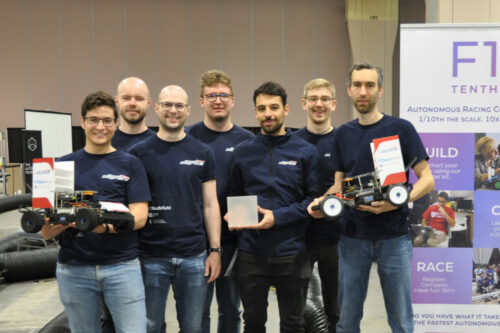Flooring your gas pedal won’t help to win the F1TENTH Grand Prix. What you’ll need is sophisticated software: The model race cars complete their laps autonomously, using artificial intelligence to recognize tracks, avoid crashes, and most importantly — go fast.
The competition was tough, but TU Wien Informatics’ team “Scuderia Segfault” won 3rd place out of 38 teams from all over the world at the 10th F1TENTH Autonomous Grand Prix in Philadelphia, USA, from May 23 to May 25, 2022.
TU Wien Informatics’ team, consisting of Daniel Scheuchenstuhl, Dennis Erdogan, Felix Resch, Luigi Berducci, Moritz Christamentl, and Stefan Ulmer, under the supervision of PreDoc Researcher Andreas Brandstätter and Professor Radu Grosu from the Resarch Unit for Cyber-Physical Systems, spent weeks preparing for the competition before heading to Philadelphia.
This time, the race was extraordinarily demanding with highly competitive teams from universities such as CMU, Rice University UCSD, UPenn, the University of Texas at Austin, ETH Zürich, the University of Bologna, and the Polish Academy of Science.
Excellent performance in the qualifiers
After the first day of open training, Scuderia Segfault already performed well in the first heat of the qualifying session. With excellent lap time and a perfectly reliable car, the number of continuous laps was high. The second heat showed how fast odds can turn in racing: The team tried to optimize the race-line and the controller further, but problems with the setup caused a fatal crash.
After the qualifying session, Scuderia Segfault achieved the second-most points (ex-equo) for the seeding of the grand head-to-head race. The team thoroughly analyzed the performance and times of the other cars, and it was clear that they needed to improve their algorithm to be competitive in the race on the last day. So they reworked the fine-tuning of every single part of the driving stack. Opponent detection, race-line, and the racing algorithm needed to be adjusted carefully. With very little time left, this was an all-in strategy.
A race by seconds
On the final race day, the first pairing against a considerably slower car was decided clearly. Scuderia Segfault’s car was driving reliably and advanced on the ladder. The next race was even more exciting since the cars touched at several overtaking maneuvers, and some minor crashes happened.
Scuderia Segfault advanced to the semi-final with a head-to-head race against team Dzik from the Polish Academy of Sciences. Both cars were driving stable and fast, but unfortunately, it was impossible to beat team Dzik.
The third-place play-off was an absolutely nerve-wracking race. Both cars from TU Wien and ETH Zürich have so far proven to be not only fast but also reliable. In the first heat, Scuderia Segfault won with just a distance of some meters, while the second heat was not in their favor. So it all came down to the tie-breaking heat to secure the 3rd place. With only seconds remaining, the team had to decide on the final tuning. Adjusting the speed factor by only 1% could make a crucial difference but could also cause a crash and obliterate all chances. So quick decisions were needed to calculate the risk. Indeed, the excitement was at the limits when Scuderia Segfault crossed the finish line and secured 3rd place!
We are grateful for the generous support of TTTech Auto, who made the participation of team Scuderia Segfault at the race in Philadelphia possible. Furthermore, we thank HTU for providing support regarding travel expenses.






